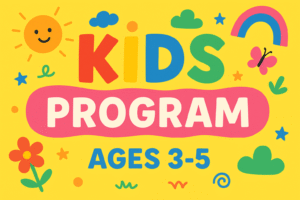Introduction: The Importance of Informal Programs for Young Children
Early childhood is a crucial period of development. Between the ages of 3 and 5, children experience rapid cognitive, social, and emotional growth. While structured preschools have their place, many parents are now exploring informal programs for kids aged 3-5—a nurturing, playful, and low-pressure alternative that encourages natural learning.
Informal learning doesn’t mean unstructured chaos—it means learning through everyday experiences, play, creativity, and exploration. In this article, we’ll explore the benefits of informal programs, how to find the right one, and how they lay the foundation for a lifetime of learning.
What Is an Informal Learning Program for Ages 3–5?
An informal learning program for kids aged 3–5 is typically a home-based, community-led, or loosely structured setup where learning happens organically through activities such as:
-
Storytelling
-
Music and singing
-
Arts and crafts
-
Outdoor play
-
Role-play and imaginative games
-
Exploring numbers, letters, and nature
These programs often avoid rigid academic schedules and instead emphasize curiosity, discovery, and interaction.
Benefits of Informal Programs for Preschoolers
Here are some core advantages of choosing an informal setup for your child:
1. Promotes Natural Curiosity
Children learn best when they’re curious. Informal settings offer flexibility that encourages asking questions, testing boundaries, and developing confidence.
2. Less Pressure, More Creativity
Unlike some traditional preschools, informal programs are often child-led. This allows kids to explore their interests without the pressure to “perform” or keep up academically.
3. Supports Emotional Development
Interacting in small groups or at home gives children more emotional security, improving communication and problem-solving skills in a safe environment.
4. Flexible and Affordable
Informal programs can be more budget-friendly and adjustable to your schedule, especially if you’re combining parental involvement with community-based activities.
What to Look for in a Good Informal Program
When selecting or creating an informal learning setup, consider the following factors:
-
Safe and clean environment
-
Experienced or nurturing facilitator (even if it’s a parent)
-
Daily routines with room for flexibility
-
Activity variety: indoor and outdoor play, reading, art
-
Opportunities for social interaction with peers
Also, ensure the program aligns with your child’s learning style and interests. Remember, at this age, the goal is exposure and experience—not performance.
Real-Life Examples: How Parents Are Using Informal Learning
Many parents build informal programs themselves or partner with neighbors, co-ops, or micro-schools. These small-scale setups blend learning through play with practical life skills.
Some use online resources and printable activities, while others engage children through field trips to local libraries, farms, or museums. This flexibility makes informal learning deeply personalized.
🌿 A great example of a thoughtfully created informal program is offered by Wisp Willow. Their approach focuses on age-appropriate, gentle learning techniques.
Explore their offering here:
👉 https://www.wispwillow.com/education/program-for-kids-aged-3-5-informally/
This program provides excellent ideas for at-home learning and is designed to support development without the overwhelm of formal schooling.
How Informal Learning Complements Modern Parenting
Today’s parents often look for balance—something between traditional schooling and unschooling. Informal programs give them this middle ground. They allow parents to take part in the learning process while still giving kids enough independence to discover things on their own.
This is especially relevant in the post-pandemic world, where home learning and community-supported education have become more accepted and accessible.
Want more parenting and education insights?
Check out our latest features and tips on Echorankit.com — where we cover everything from early learning trends to modern parenting hacks.
Final Thoughts: Give Your Child the Best Start
An informal program for kids aged 3–5 can be just what your child needs to develop essential life skills in a playful, low-pressure environment. Whether you’re organizing it yourself, joining a local group, or following a trusted online guide like Wisp Willow, informal learning helps plant the seeds of a lifelong love of exploration and creativity.
The early years should be filled with joy, discovery, and encouragement. And informal programs are proving to be one of the most effective—and enjoyable—ways to make that happen.
Tags: early childhood education, informal preschool, learning through play, toddler programs, age 3-5 development, home learning ideas
Published on: Echorova.com
